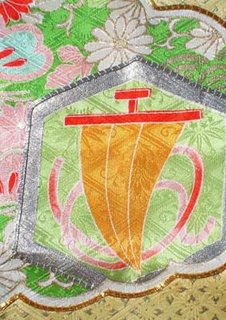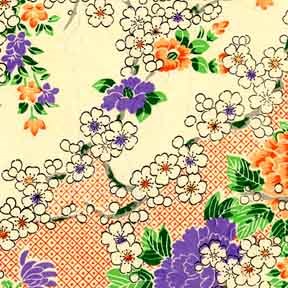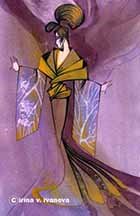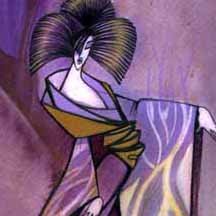I just created webring on
Xanga.com Let us see may be other interested in Kimono bloggers will share my search.Friday, September 29, 2006
Thursday, September 28, 2006
kimono fabric

Beautiful kimono fabric from Japan courtesy of fellow blogger from Adventures in Tokyo blog . She promise to post more of Kimono related images from her collection. I am looking forward to that .
Wednesday, September 27, 2006
"Tuck a kimono blouse into a pencil skirt"- TURNING Japanese
 Acording to Lowell Sun Online - Fashion is turning Japanese:
Acording to Lowell Sun Online - Fashion is turning Japanese:Is it a new fashion trend ?

Slip into a flattering look that is making waves from Tokyo to Tyngsboro -- Kimono-inspired dresses and tops.
Kimono fashion?Why not? It is democratic:
it is not for size 2's only.
With flowing sleeves and fitted high-waists, most anyone call pull off this style.
Sunday, September 24, 2006
Friday, September 22, 2006
M. Kathleen Colussy presented: TraDigital
Author and designer M. Kathleen Colussy explore this direction making digital kimono demonstrating an excellent match of high tech printing technology and traditions of kimono.

Last year she presented digital Kimono on art show TraDigital at Mark K. Wheeler Gallery Fort Lauderdale
According to Kathleen Colussy: the works are comprised of several different mediums including painting, photography, and digital rendering. The pieces have all been digitally printed on substrates of natural and synthetic fibers.

According to Kathleen her hopes are that in her art one can see that she enjoys exploring the freedom of combining several mediums into art that embrace and celebrate life, cultural diversity, spirituality, faith and the art of story telling.
 For this reason she has referred to her art as Tra-digital, because her art reflects both the traditional and non-traditional means of expression
For this reason she has referred to her art as Tra-digital, because her art reflects both the traditional and non-traditional means of expressionKathleen is ever trying to combine high tech and high touch to express a message of choice and consequences.

In addition to the show, Kathleen will were signing her two newest books for Prentice Hall/Pearson Publishing Entitled:
Fashion Sleuth- How to Research and Resource the Internet
Rendering Fashion, Fabric and Prints with Adobe Illustrator
by: M. Kathleen Colussy and her co-author: Steve Greenberg

M. Kathleen Colussy
images are courtesy of M. Kathleen Colussy .
M. Kathleen Colussy teaches at Fashion Department of The Art Institute of Fort Lauderdale.
Tuesday, September 19, 2006
Sunday, September 17, 2006
Fabrics for Kimono:Chirimenis fabric of choice?
Chirimen is a type of Japanese silk crepe used for kimono.
According to Chirimen is wrinkled (crepe paper)Traditionally, women quilted leftover pieces of the fabric and made small ornaments that look like flowers, birds, animals, dolls and toys. The handiwork was handed down as a way to enhance one's needlework and artistic sense. At the class, one of the program members will teach how to make a silk camellia flower and other items.
For some reasons on according to this source
Yuzen paper, by Japanese handmade cotton texture paper. So,what is it, paper or fabric or both? We are trying to figure it out an we will post info on further research as far as we clarify that.
Any way, according to this commercial source "Chirimen silk. This is a kind of crepe silk.” And we will stick with this definition for the time being .
However on on the this Japanese fabric website Chirimen is not a silk, it is rayon and they use term "Hitokoshi" chirimen, which "has smaller surface wrinkles than other kinds of chirimen crepe."
Friday, September 15, 2006
international kimono?
By the beginning of the Showa period (1926–1989),men's clothing had become largely Western, and the business suit was standard apparel for company employees.This is apparently why men’s kimono in today’s Japan require additional efforts to stay afloat (see previous artofkimono posting ) knowing that “today, kimono have become much less common a sight in Japan.” . The question “What is the Future of Traditional Japanese Dress?” has no obvious answer for Japan. But international influence of kimono tradition is huge. I would say that kimono no longer belongs to Japan even though it originated in Japan the same way as tailored jacket no longer belongs to western Europe only.
In the same way as Harajuku fashion concept embraced western concept of fashion into Japanese cultural mode, western civilization absorbed idea of kimono.
Tuesday, September 12, 2006
must read:The Japanese Revolution in Paris Fashion
Monday, September 11, 2006
paper dolls kimono’s
According to this source
“Washi Ningyo (Japanese Paper Dolls) found its origin in a paper doll called "Anesama" Ningyo", which was favored by girls of all ages throughout Japan during the last 500 years.”
See examples of anesama and other Japanese paper craft on the page of National Clearinghouse for U.S.-Japan Studies of Indiana University
Interesting that there is special term for "elder sister doll" : which is “Anesama ningyoo” in Japanese. “There is a deep history to these paper dolls. In the Japanese feudal society, the common people were stuck within the social class in which they were born.”

Kimono for paper dolls was created form CHIYOGAMI which is According to Kimberly Crane’s brief but very informative article at kimscrane.com a “type of Japanese paper decorated with brightly colored, woodblock-printed patterns.”
Some examples of CHIYOGAMI patterns Images are courtesy of choya.com
You can see as an illustrations for my brief research

You can some images of accessories form Chiyogami
Sadly enough wooden dolls and other Japanese craft
are out of the topic of kimono focused research , may be next time?
Wearing Propaganda: kimono as a political statement
Can kimono be a political statement? Sure it can take a look on Kimono’s of 1930’s and 1940’s and judge for yourself . Review form exhibition Wearing Propaganda: Textiles on the Home Front in
Sunday, September 10, 2006
kimono patterns
Art of Kimono, now in watercolor

The medium is watercolor with light touch of gouache.
It is very special technique originally created by artist through years of practice and experimentation, by fusion of different traditions of watercolor painting into new innovative manner.

Excellent resource on Traditional dress of China, Japan and Korea
History and Concept of kimono as well as